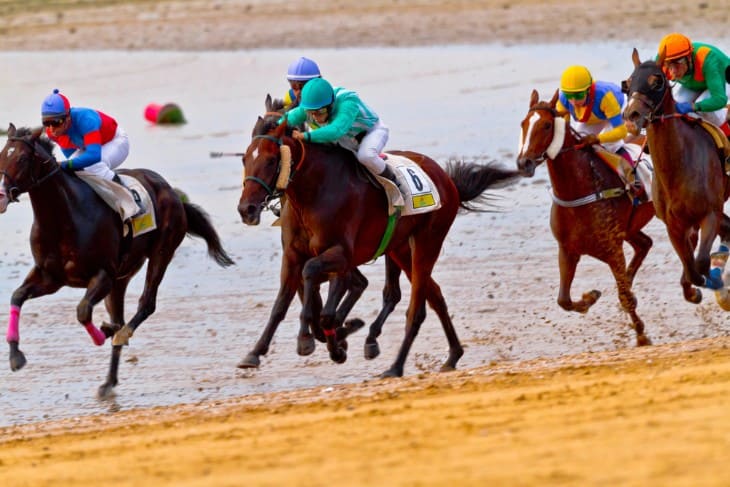In sports betting and entertainment, virtual horse racing has emerged as a gripping trend. Powered by advanced technology, it's quickly attracting both enthusiasts and bettors. Combining lifelike graphics, sophisticated simulations, and artificial intelligence, virtual horse racing mimics the thrill of real races.
This article delves into the rise of virtual horse racing, contrasts it with traditional horse racing, and explains the betting dynamics. Whether you're an experienced horse racing enthusiast or just starting, this piece will illuminate the virtual racing world for you.
Virtual Horse Racing
Virtual horse racing is an interactive simulation of live horse racing, bringing the excitement of the turf to the digital domain. Although the origins of virtual horse racing can be traced back to early computer games, it has come a long way since then, evolving into a sophisticated and captivating experience.
At the heart of virtual horse racing lies an intricate blend of technology and creativity. Expert programmers and designers work in tandem to create virtual tracks and venues that encapsulate the essence of real-life racecourses. Every minute detail, from the texture of the track to the grandstands filled with cheering spectators, is meticulously crafted to ensure a lifelike experience for players.
The allure of virtual horse racing lies in its accessibility and convenience. Unlike real-life horse racing, which is bound by schedules and geographical limitations, virtual races can be enjoyed at any time, from anywhere in the world. This flexibility allows enthusiasts to indulge in their passion for horse racing without being constrained by external factors.
The Appeal of Virtual Horse Racing
The surge in the popularity of virtual horse racing is not without reason. This virtual experience offers a fresh take on the traditional horse racing scene, catering to a diverse audience with varying preferences. One of the primary appeals of virtual horse racing is its fast-paced nature, providing instant gratification to those seeking quick results and exhilarating races.
For horse racing enthusiasts, virtual racing acts as a delightful complement to real-life events. It allows them to experience the thrill of races at their convenience, filling the gaps between live events and providing an ongoing source of entertainment. Furthermore, virtual horse racing enables fans to explore tracks from around the world, broadening their horizons and enriching their understanding of different racecourses.
Novice punters find virtual horse racing particularly attractive due to its simplicity and low entry barrier. Unlike traditional horse racing, where in-depth knowledge of form, jockeys, and trainers is often required, virtual racing levels the playing field. Bettors can dive in with minimal understanding and gradually develop their expertise as they gain experience.
Virtual vs. Real-Life Horse Racing
As virtual horse racing continues to soar in popularity, it naturally invites comparisons to its real-life counterpart. Both forms of horse racing share the same fundamental objective: to witness the exhilarating spectacle of horses thundering down the track, striving for victory. However, the paths they take to deliver this excitement diverge significantly.
In real-life horse racing, the outcomes are determined by the physical prowess and form of the racehorses, the skill of the jockeys, weather conditions, and various other unpredictable factors. Virtual horse racing, on the other hand, relies on advanced algorithms and artificial intelligence to simulate the races. While randomness and unpredictability are still key components of virtual racing, they are generated through a different set of parameters.
One of the notable differences between virtual and real-life horse racing is the pace of events. In the world of virtual horse racing, races can be run at a significantly faster pace, allowing players to enjoy multiple races in a short period. This fast-paced nature caters to those seeking instant gratification and a quick thrill.
Despite the differences, virtual horse racing enthusiasts often assert that it complements, rather than competes with, traditional horse racing. Virtual races can be an engaging way to fill the gaps between live events or during the off-season, keeping the excitement alive year-round. Some punters even use virtual racing as a testing ground for strategies that they can later apply to real-life betting.
The Technology Behind Virtual Horse Racing
The magic behind virtual horse racing lies in the seamless fusion of cutting-edge technology and creative ingenuity. Behind the captivating virtual racecourses and lifelike horses is a complex web of algorithms, simulations, and data.
Sophisticated software and powerful computers are harnessed to create the stunning graphics and animations that make virtual horse racing so immersive. The rendering of tracks, horses, and environments demands meticulous attention to detail, ensuring that players are transported to a realistic virtual world.
One of the significant technological achievements in virtual horse racing is the implementation of artificial intelligence (AI). AI plays a pivotal role in generating the unpredictable outcomes that make each race unique and exciting. It simulates the behavior of individual racehorses, factoring in their virtual training, form, and racing histories, resulting in a diverse array of race scenarios.
Developers continually refine and update the technology behind virtual horse racing, striving for greater realism and accuracy. As technology continues to advance, we can expect even more lifelike and engrossing virtual racing experiences, blurring the lines between reality and digital entertainment.

Creating Realism in Virtual Horse Racing
The success of virtual horse racing hinges on its ability to create a truly immersive and realistic experience for players. To achieve this, developers invest significant effort in crafting virtual worlds that capture the essence of real-life horse racing venues.
Graphics and audio play a vital role in recreating the ambiance of a live racecourse. From the texture of the turf to the thundering sound of hooves, every element is designed to evoke the sights and sounds of a real horse race. High-definition graphics and attention to detail bring the virtual horses and jockeys to life, allowing players to feel like they are witnessing an actual race unfold before their eyes.
Balancing realism with entertainment value is a fine art in virtual horse racing development. While the objective is to mimic the experience of real racing, certain elements may be tweaked or enhanced to make the races more visually engaging and enjoyable for players. Striking this balance ensures that virtual horse racing appeals to both avid racing fans seeking authenticity and casual players looking for a thrilling entertainment experience.
Betting on Virtual Horse Racing
As virtual horse racing gains momentum, so does its betting market. Betting on virtual races follows a structure similar to real-life horse racing, offering a plethora of betting options to punters.
One of the most common bets in virtual horse racing is the classic "win" bet, where players predict the horse that will finish first in the race. Punters can also opt for "place" and "show" bets, predicting a horse to finish in the top two or top three, respectively. These bets offer slightly lower payouts than a win bet but provide more chances of winning.
For those seeking more challenging bets, virtual horse racing presents enticing options like Exacta, Trifecta, and Superfecta. In an Exacta bet, players must predict the first two horses in their exact finishing order, while a Trifecta extends the prediction to the top three horses. A Superfecta takes it a step further, requiring players to correctly predict the top four horses in the precise order of finish.
The odds in virtual horse racing are determined by a combination of AI-generated probabilities and player preferences. As with traditional horse racing, the odds may fluctuate based on the perceived chances of each horse winning the race.
Before diving into virtual horse racing betting, it's essential to set a budget and adopt responsible gambling practices. Virtual racing's quick pace and convenience can be enticing, but disciplined betting ensures an enjoyable and sustainable betting experience.
Virtual Horse Racing Events and Tournaments
In the vibrant world of virtual horse racing, prestigious events and thrilling tournaments are held regularly, attracting punters from all corners of the globe. These events showcase top virtual racehorses, and just like real-life racing, they compete for glory and substantial prize pools.
Some of the most popular virtual horse racing events are inspired by their real-life counterparts. Virtual renditions of prestigious races like the Grand National, Kentucky Derby, and Melbourne Cup offer fans a chance to experience the excitement of these iconic races in a digital format. Virtual events often run alongside their real-world counterparts, creating an atmosphere of celebration and engaging both virtual and real-life racing enthusiasts.
Additionally, virtual horse racing tournaments introduce an element of competition and strategy. Punters can participate in virtual leagues and championships, where they can showcase their betting prowess and compete against others for recognition and rewards. These tournaments are typically organized by betting platforms or virtual racing providers, adding an extra layer of excitement to the virtual horse racing experience.

Virtual Horse Racing and Responsible Gambling
As virtual horse racing gains popularity, it's essential to emphasize the significance of responsible gambling. The accessibility and convenience of virtual races can be appealing, but it's crucial for punters to exercise self-discipline and set limits to ensure a positive betting experience.
Responsible gambling involves understanding that betting is a form of entertainment and not a guaranteed source of income. Setting a budget for virtual horse racing bets and sticking to it helps prevent overspending and potential financial strain. Punters should view any losses as part of the gaming experience, and never chase their losses in a bid to recoup money.
Furthermore, operators of virtual horse racing platforms play a vital role in promoting responsible gambling practices. They should provide tools that allow punters to set deposit limits, betting caps, and self-exclusion options. Moreover, educational resources on responsible gambling should be readily available to users, helping them make informed decisions and stay in control of their betting activities.
Collaboration between operators and regulators is also essential in safeguarding punters from excessive gambling. Implementing age verification procedures ensures that virtual horse racing remains a responsible and adult-oriented activity. Stringent measures against fraud and illegal betting help maintain the integrity of virtual races and protect punters from unscrupulous practices.
By prioritizing responsible gambling, punters can fully embrace the thrill of virtual horse racing while maintaining a healthy and enjoyable betting experience. As the virtual racing revolution continues, fostering a culture of responsible gambling will be pivotal in ensuring the sustained success and positive impact of this dynamic equestrian innovation.
The Future of Virtual Horse Racing
As virtual horse racing continues to captivate audiences worldwide, the future looks promising and filled with exciting possibilities. Technological advancements play a pivotal role in shaping the evolution of virtual racing, making it increasingly realistic and engaging.
One area of development that holds immense potential is the integration of augmented reality (AR) and virtual reality (VR) technologies. Imagine donning a VR headset and being transported to the heart of a virtual racecourse, surrounded by cheering crowds and thundering hooves. AR could further enhance the betting experience by overlaying virtual horses on real-world surroundings, allowing punters to witness "live" virtual races in various locations.
The application of blockchain technology also has the potential to revolutionize virtual horse racing. Blockchain's inherent transparency and security can introduce greater trust and fairness to the virtual betting process. Smart contracts could streamline payouts and ensure prompt and accurate distribution of winnings, further enhancing the overall betting experience.
Additionally, developers are likely to focus on refining the AI algorithms that drive virtual horse racing outcomes. Improving the realism of horse behavior, factoring in more variables, and creating even more diverse racing scenarios will contribute to a richer and more immersive virtual racing experience.
As the lines between virtual and real-life horse racing blur, we may witness cross-pollination between the two realms. Virtual racehorses could gain recognition and fame beyond the digital arena, leading to collaborations between virtual and real-life stables. Such innovative crossovers would undoubtedly create unprecedented excitement and new possibilities for the equestrian community.








